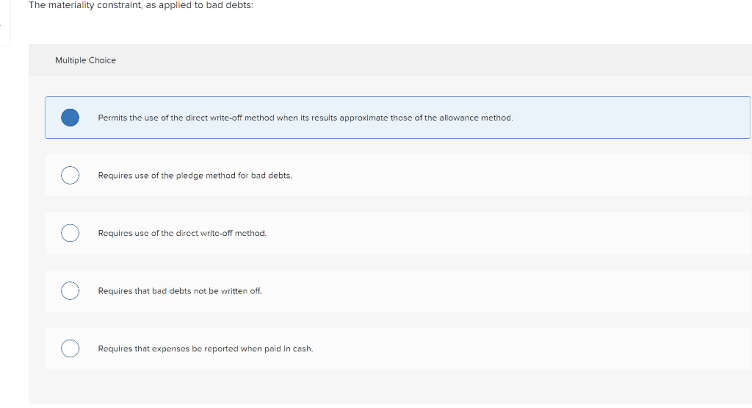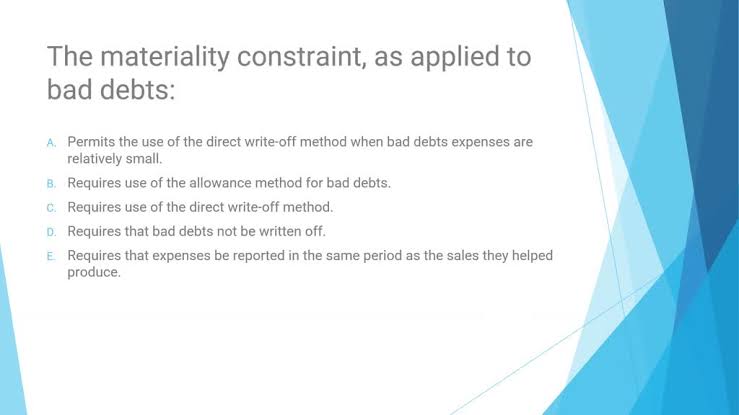The Materiality Constraint As Applied To Bad Debts. All details, answers & video below.
The Materiality Constraint As Applied To Bad Debts
The materiality constraint as applied to bad debts:
- a. Requires use of the direct write-off method.
- b. Requires use of the allowance method for bad debts.
- c. Permits the use of the direct write-off method when bad debts expenses are relatively small.
- d. Requires that bad debts not be written-off.
- e. Requires that expenses be reported in the same period as the sales they helped produce.
- Answers
Generally Accepted Accounting Principles (GAAP) require the use of the allowance method. The provisioning method requires companies to estimate and record bad debt expense during the same period of the sale. When an account is deemed uncollectible, they debit an account called appropriation and accounts receivable for doubtful accounts.
The direct deduction method, on the other hand, is generally used by small companies with very little receivables. Under this method, doubtful receivables expense is recognized on the date the account is cleared. The materiality constraint says that companies can ignore an amount that is too small to have an impact on the financial statements. This is considered trivial and irrelevant to external users making business decisions.
Thus, the materiality restriction applied to bad receivables allows the direct charge-off method to be used when bad debt expenses are relatively small. Therefore, the answer is c. The Materiality Constraint As Applied To Bad Debts video below.
In this video, I am going to walk you through how companies account for the possibility of bad debts in their receivables. And specifically, I’m going to do so using what’s known as the allowance method. Let’s take a look. All right, first up, a brief primer on receivable valuation. So whenever you record a receivable on your books, you typically record it.
At the amount that is owed to you because you expect that someone will pay you what they owe. However, subsequently you are going to adjust your receivables for any amount that is estimated to be uncollectible or known for a fact to be uncollectible. So to the extent that you don’t think your receivables will get paid. You must go ahead and adjust the receivable on your balance sheet to reflect the amount you don’t think you’re going to get paid. The Materiality Constraint As Applied To Bad Debts.

And then US gap requires companies to use what is known as the allowance method of doing these bad debt estimations. The alternative to this is what’s known as the direct write off method, and I won’t be discussing that in this video. That is actually not allowed under US GAP. So the focus of this video will be on what’s known as the allowance method. You will see where that name comes from in just a moment. All right, so here we go.
The Materiality Constraint As Applied To Bad Debts: What is the allowance method? How does it work? Where does the name come from? Well, here’s the deal. Under the allowance method, whenever. A company estimates that a certain amount of its receivables are uncollectible. It is required to record bad debt expense. So you are going to have a journal entry, it’s going to say bad debt expense and that’s going to be the debit in your journal entry.
Okay, notice that bad debt expense. That is going to hit your income statement. That’s going to be an operating expense on your income statement that is going to reduce your net income. And the interesting thing here is this is based on an estimate of what you don’t think you’re going to get. This doesn’t really reflect who didn’t pay you. It’s actually only saying what do we think we’re not going to get paid. And and I’m going to revisit that in a in a little bit. Now we need a credit for this journal entry.
The Materiality Constraint As Applied To Bad Debts: And so that’s where this second bullet comes in when you’re using the allowance method. The estimated uncollectibles are tracked on the balance sheet in a Contra asset account that is known as the allowance for doubtful accounts. So the credit in this journal entry allowance for Doubtful accounts, again, that is a Contra asset on your balance sheet that is going to show up right beneath.
The receivable, so it’s going to say AR Less allowance for doubtful accounts. This presentation enables investors to see what did customers owe you and how much of that do you think you’re not going to get paid. All right, Next up, when an estimated uncollectible becomes a known uncollectible. So remember at this point we’ve only estimated that we’re not going to get paid and that’s what we’ve recorded.
The Materiality Constraint As Applied To Bad Debts / But at some point we’re going to know for sure whether we’re getting paid or not. So in the instance where we find out for sure that we are not going to receive a portion of our of a receivable, we are going to do what’s known as a write off. We’re going to write off that receivable from our books now since a receivable is an asset to write it off. We are going to credit it.
So credit in this case, I’m going to just call it accounts receivable, but this could work for any other receivables. But you’ll typically see it most often in accounts receivable. We’re in credit, accounts receivable. That is the process of writing off the receivable from the books. Now if you think about this in a situation of getting paid, when you get paid, your journal entry looks like this.
The Materiality Constraint As Applied To Bad Debts – Cash, debit, AR credit, right, You collected money, so you took the receivable off the books. The difference between that and this is we’re not getting money, we’re not getting anything. The receivables still coming off the books, but this is actually kind of costing us because we’re not collecting the cash for it. At the same time, the debit that’s going to go on this instead of cash because we’re not getting paid the debit here is going to be the allowance for doubtful accounts.
Now what’s the logic behind doing this well? Remember, the allowance for doubtful accounts is tracking what we think. We won’t get paid, right? And so to the extent that some of it has come true, the AR goes away. But our estimate is no longer needed either, because it came true. It’s no longer an estimate. And so the estimate is going away as well. Notice it was a credit to establish that estimate.
The Materiality Constraint As Applied To Bad Debts / It’s a debit to make it go away. Right. So this is this process right here. This is called the write off. All right. Last thing that can happen. What if you write off an account, but eventually, say whoever you wrote off, they have a turn of fortunes there. They get back in financial health and they say, hey, we want to make good on our payment, They ultimately pay you.
The Materiality Constraint As Applied To Bad Debts: All right, well, again, think of what a payment of a R looks like. It traditionally involves you get cash, you take the AR off the books. Now, the only thing that makes this special is in this case, we’re talking about collecting cash for a R that already came off the books. That’s a little bit of a problem because we can’t take it off the books twice, right?
We have to take it off the books. It’s not there anymore to take off again. Well, the way you solve this hiccup is you essentially reverse the write off. So I’m going to move that collection down and above it, I’m going to say how about this debit AR to put the AR back on the books. Credit allowance allowance for becomes a pain to to write after a while.
The Materiality Constraint As Applied To Bad Debts: Credit allowance for doubtful accounts to put the estimate of what we think we won’t get back on the books, right. We’re essentially just taking this, this write off. And we’re reversing it. We flip-flopped it so we undid the write off. Now the AR is still on the books now we can collect it and and this process right here is known as a recovery. You recovered a previously written off account.
Now one question I I I get from students a lot as they say well wait a minute you debited AR and you credited AR. Would it be okay to simply record what you see in the middle here. Would it be okay to simply debit? https://homework.study.com/explanation/the-materiality-constraint-as-applied-to-bad-debts-a-requires-use-of-the-direct-write-off-method-b-requires-use-of-the-allowance-method-for-bad-debts-c-permits-the-use-of-the-direct-write-of.html
- The Angle Created By Ray Ox And Ray Oz İs Angle .
- Convert 42 Celsius To Fahrenheit
- There is no unique or exclusion constraint matching the on conflict specification
- What Percent Of A Standard Normal Model İs Found İn Each Region? Draw A Picture First.
- What is the domain of the function mc007-1.jpg? mc007-2.jpg mc007-3.jpg mc007-4.jpg mc007-5.jpg.

